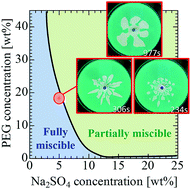Anomalous patterns of Saffman–Taylor fingering instability during a metastable phase separation
Abstract
Phase separation is important in biology, biochemistry, industry, and other areas and is divided into two types: a spinodal decomposition type and a nucleation and growth type. The spinodal decomposition type phase separation occurs under the thermodynamically unstable conditions, and the nucleation and growth type phase separation occurs under thermodynamically metastable conditions. On the other hand, when a less viscous fluid displaces a more viscous one in porous media, the interface of the two fluids becomes hydrodynamically unstable and forms a finger-like pattern. The coupling of the hydrodynamic instability with the thermodynamic instability has been studied. It is reported that the hydrodynamic instability under thermodynamically unstable conditions, where spinodal decomposition type phase separation occurs, creates multiple moving droplets with a radius of 3–4 mm because of the spontaneous convection induced by the Korteweg force, which is driven by a compositional gradient during phase separation. However, the hydrodynamic instability under metastable conditions, where the phase separation of nucleation and growth type occurs, is still unrevealed. In this study, we applied fingering instability (hydrodynamic instability) under the metastable conditions, where the patterns are changed from fingering or droplets to anomalous patterns such as tip-widening or needle-like (top-pointed) fingering patterns when the initial concentration is metastable, which is considered near a binodal curve. These patterns are ubiquitous in nature, similar to dendrite crystals (snowflakes) or our body's cells. Thus, the patterns created can be controlled through hydrodynamic conditions such as the injection flow and thermodynamic conditions such as spinodal decomposition (thermodynamically unstable conditions) and metastable conditions.



 Please wait while we load your content...
Please wait while we load your content...